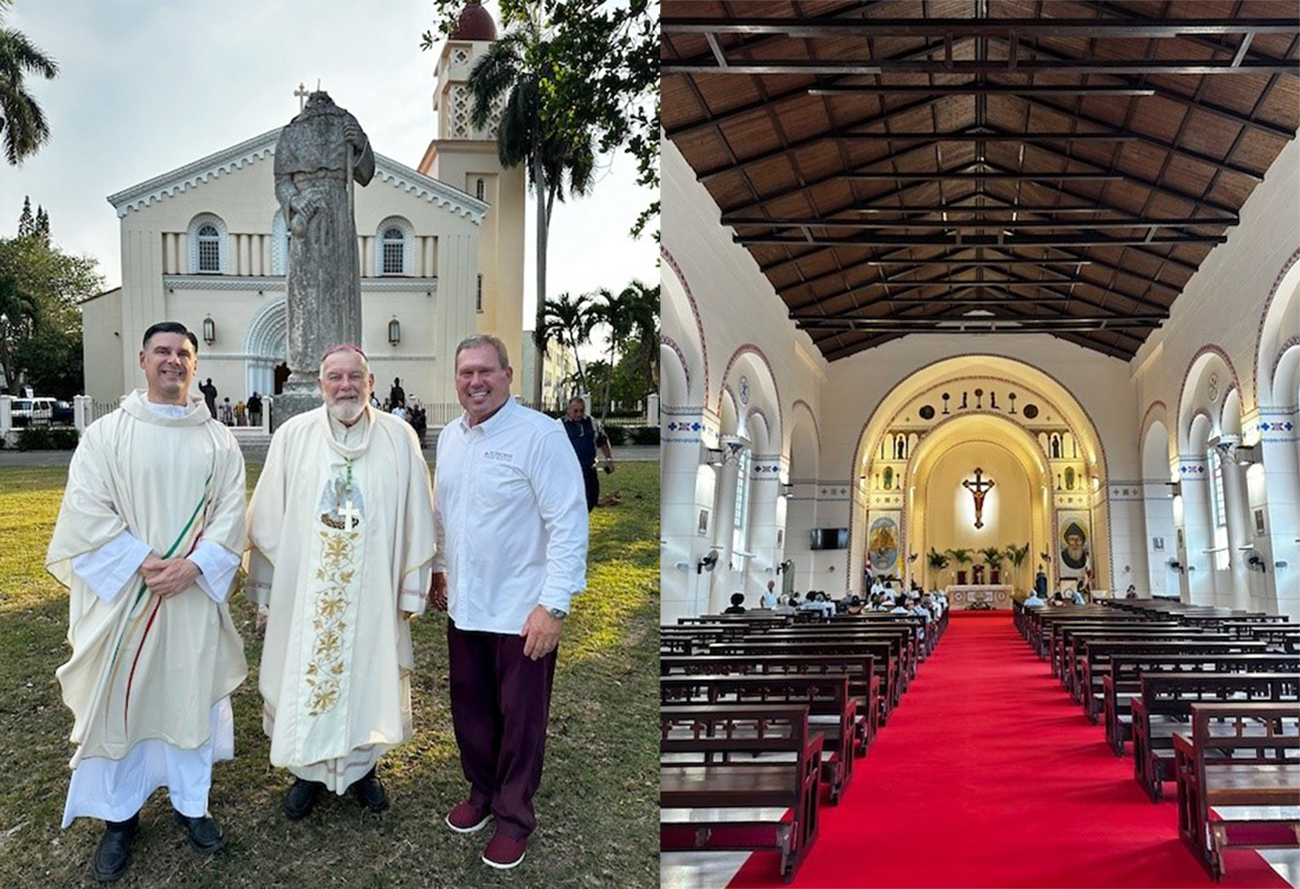
He was brought to tears.
When St. Thomas University President David A. Armstrong, J.D., visited Cuba in April, he was stunned by what he saw.
The occasion was a ceremony to mark the reconstruction of a Havana chapel — work that was financed largely by the USA-based Catholic Extension Society.
But this was not just any chapel.
This was the chapel on the campus of the Universidad de Santo Tomas de Villanueva, the university that was destroyed shortly after communist dictator Fidel Castro took over Cuba in 1959.
Indeed, Castro’s militia confiscated the university’s land in 1961, forcibly expelling priests and professors and decapitating the school’s statue of Santo Tomas.
Some Augustinian priests soon fled to Miami, where they established Biscayne College, a Catholic school for men. In time, the school became co-educational, and, in 1984, its name was changed to St. Thomas University, which more closely aligned to its Cuban origins that date all the way back to its founding in 1946.
Which brings us back to this past April, when President Armstrong was part of a traveling delegation that included Miami Archbishop Thomas G. Wenski and Father Rafael Capo, who is STU’s Vice President for Mission and Ministry.
Initially on this trip, President Armstrong had one primary concern.
“I have been very vocal about my disdain for communism,” President Armstrong said, “and that made me a little nervous in regard to our security in Cuba.”
President Armstrong’s fear soon turned to excitement as his plane hovered over Cuba’s beaches.
“I’m from Cleveland,” Armstrong said, “and anytime I can go to an island, I’m thrilled.
“I could see that the water was so beautiful … But, when we started getting closer to land, I couldn’t help but notice that the buildings in Cuba were completely decimated.
“It looked like a country that had been bombed out by war. But, in the case of Cuba, it wasn’t a war. It was instead ravaged by communism.
“That’s what brought me to tears – that what once was such a beautiful country had been left to rot and was now broken down and crumbling.”
President Armstrong said he immediately thought of all the wonderful Cuban-Americans he has met, befriended, and worked with in six years as STU’s president.
“I know a lot of Cubans who have wanted to go back to the island when it’s free,” Armstrong said. “But what would they be coming back to?”
President Armstrong, on his drive into Havana, said he was saddened to see entire buildings plastered with giant images of communist leaders of yesteryear, such as Fidel Castro and Che Guevara.
But, as Armstrong reached the San Charbel Parish, he could clearly see the positive results of the years-long planning, the fund-raising, and the physical restoration of the Santo Tomas de Villanueva chapel, which had been fully restored after decades of having been used by the Cuban government as a storage facility.
It is now known as the most beautiful church in Cuba.
How did all of this happen?
Well, it started with Pope John Paul II’s visit to Cuba in 1998.
“The Pope asked the communist government to give back places of worship to the church,” Father Capo said. “The government agreed, and, as an act of goodwill, the chapel of Santo Tomas was one of the ones that was given back to the church.
“But it was in such disrepair that without American and other international help it would’ve been impossible for the Cuban government to restore.”
Plans to renovate the Santo Tomas chapel were rocket fueled after Pope Francis’ 2015 visit to Cuba. During that visit, a small delegation of Miamians — including STU faculty members – toured the shuttered campus and wondered whether it could be restored to serve its community.
At the time, the church had an exposed ceiling with little or no furnishings or religious art.
Enter the Catholic Extension Society (CES), a 119-year-old Chicago-based organization that funds and serves the country’s poorest mission dioceses.
But while the CES does indeed support many poverty-stricken communities, the Cuba project is among its first endeavors beyond U.S. borders.
Father Patrick O’Neill said the CES first went to Cuba seven years ago, driving through eight dioceses in one day to get a feel for the community’s needs.
“The Catholic Extension Society made regular visits to Cuba to check on progress,” Father O’Neill said. “But due to the difficulty of obtaining building materials, progress was slow.”
Father O’Neill, who was STU’s president from 1978 to 1988 – growing enrollment from 600 students to 3,000 while also starting up the law school – said restoring the Santo Tomas chapel was a labor of love since it honors his heritage as a former Augustinian priest and educator.
In fact, O’Neill’s parents had been supportive of the original chapel’s founding. Fast forward several decades, and Father O’Neill – according to Father Capo — was one of the big donors in the restoration project.
During the restoration of the Santo Tomas chapel, a poignant decision was made to leave the headless statue of Santo Tomas unrepaired as a reminder of the decades-old conflict between church and state.
Bringing everything full circle, Father Capo said there are hopeful plans for the future.
“With the support of Archbishop Wenski and President Armstrong, we at St. Thomas University will explore possibilities to support some educational projects for the church in Cuba,” Capo said. “Possibilities include an outreach program, online education and/or sending some professors to Cuba. We may look at higher-education certificates or even a degree in Havana to support the church in Cuba.”
Father Capo, whose grandfather was born in Cuba, said this trip to the island – his first – was special.
“I saw the poverty and the suffering of the people,” Capo said. “It was painful to see. But it was also gratifying to witness people keeping the faith.
“They are hopeful – even in the midst of their pain. People were welcoming us and giving us their best even though it’s little that they can offer.
“In addition, the auxiliary bishop took me to the street where my grandfather was born, and we visited the parish and the church of San Nicolas in Havana where we suppose he was baptized.
“It was deeply moving.”
It was also deeply moving for President Armstrong, who was so impacted by what he saw in Cuba that he made it the centerpiece of his STU commence speech in May.
After telling the story of STU and its Cuban roots, Armstrong took on the Cuban government once again.
“Communism and socialism have failed in every single country that they’ve been,” Armstrong said. “People will say that Jesus was a socialist.
“No! Jesus believed in human flourishing. The Catholic church believes in human flourishing. Capitalism is the way to human flourishing.”
President Armstrong then brought it all home when he spoke about the importance of God in our lives. He noted what he called “the stunning beauty” of the chapel restored with the huge help of $3 million in international donations, spearheaded by Father O’Neill and Catholic Extension.
But he also saw that the other seven buildings on that campus were in massive disrepair.
“I could not help but think of the metaphor,” President Armstrong said. “When you believe that mankind can create Utopia, it looks like those seven destroyed buildings.
“But when you put God at the center of your life, it looks like that beautiful, restored chapel.
“So again, graduates of St. Thomas University … Ethical leaders for a global community – that is our mission. Keep God at the center every day of your life.”

